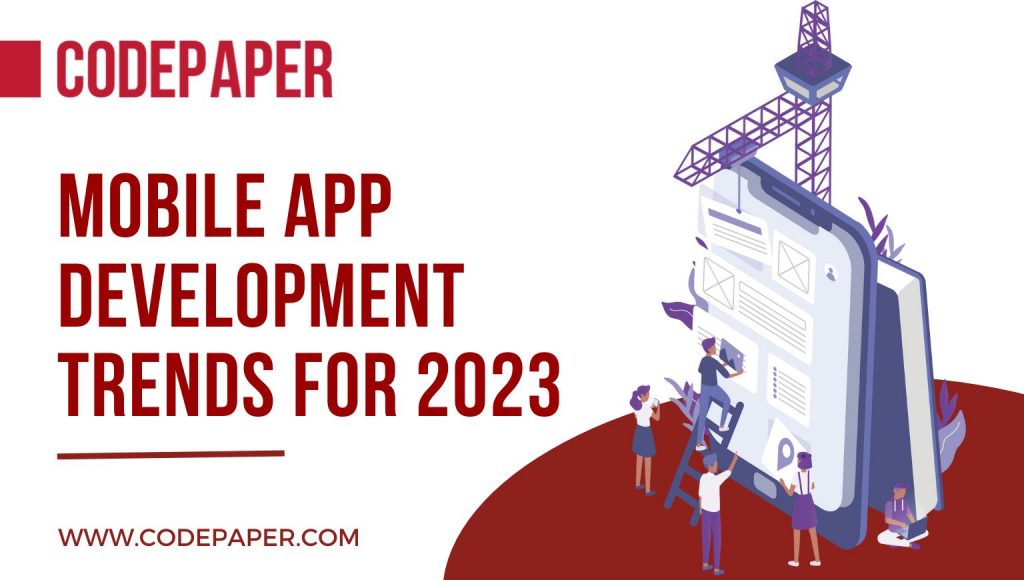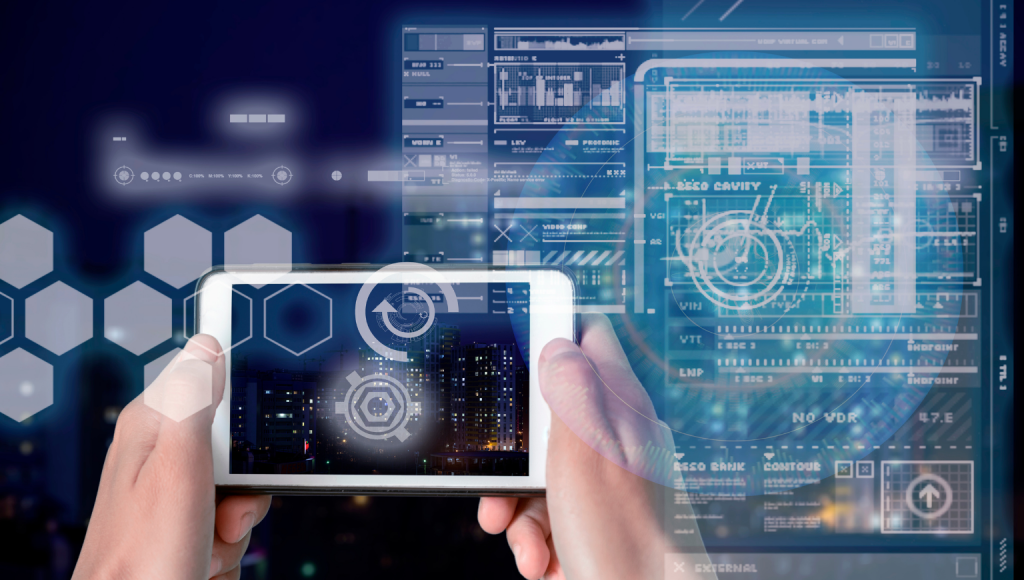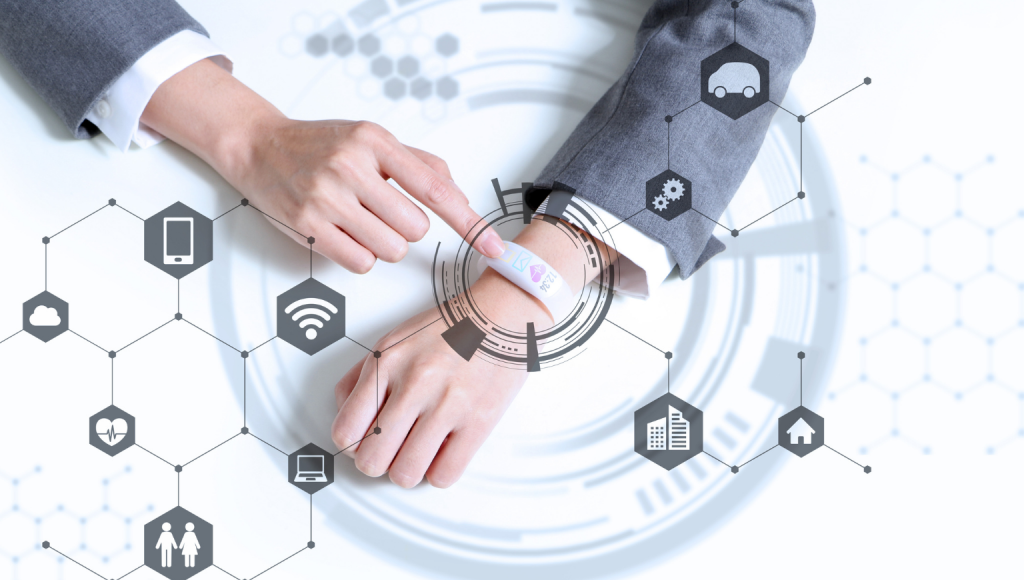Are you ready to take your mobile app development to the next level? We’ve got the intel you need! Here’s our roundup of the top 10 mobile app development trends set to disrupt the industry in 2023. Get inspired and get ahead of the curve – it’s time to prepare for a revolutionary year of mobile app development!

What is mobile app development?
Mobile app development is the process of creating mobile applications for phones and tablets. The entire process involves conceptualizing an idea, planning the execution, coding, testing and launching. In order to create a successful mobile app, developers need to have a thorough understanding of the latest trends that govern this field.
A mobile application is software that runs on a platform such as iOS or Android. It can be used for a variety of activities such as checking emails, playing games or booking tickets. Mobile app developers use multiple programming languages and technologies to create applications compatible with different operating systems and devices.
Mobile app development can be both cost-effective and time-saving when done right. With smart investments into the development cycle upfront, you’ll save time and money throughout the entire project development cycle from design to launch. To ensure success in your mobile app projects, it’s important to stay on top of the most recent trends in mobile development before making any decisions about your project’s scope or timeline.
Toronto has many tech-savvy mobile app stores featuring some of the best apps from around the world. The city caters to sophisticated software platforms with user experience at its forefront; thus giving customers an unmatched experience when downloading or using these apps developed by Toronto’s own local developers for Toronto’s own tech community members here in town!
5G

Mobile app development is continuously evolving and changing, largely due to the rapid advances being made in our mobile networks. 5G is the fifth generation cellular technology, which optimizes data rate and connection speed. With 5G becoming more mainstream and rolling out to consumers, developers are beginning to explore the benefits that it provides for mobile applications.
5G promises improved speeds compared to 4G networks—up to multiple gigabits per second and low latency of 1ms or less. This will provide a faster experience while reducing power consumption in devices like phones, tablets and wearables. Developers can take advantage of this new level of speed by creating more immersive experiences with virtual reality, augmented reality and gaming apps that take less time to load or process graphics-heavy content. In addition, communications can be improved since 5G has a quicker response time over 4G which can enhance communication within games.
5G also opens up new possibilities for developers by allowing for more frequent updates without crashing apps or causing lags in user experience. This helps them ensure users have an optimal experience when using their application – even if they’re downloading large amounts of data in real-time. Furthermore, shorter download times could expand access potentials to those with limited bandwidths – including users in rural areas or travelling abroad!
The arrival of 5G presents app creators with exciting opportunities that were previously distant dreams due to current network capabilities but with it comes challenges as well — such as finding services compatible with 5g on different device models leading us into a whole new sphere of app development needs yet discovered!
Blockchain

As technology evolves, so do mobile app development trends, and in 2023 this is likely to be especially prominent. One of the biggest new trends that we predict will make a significant impact on the mobile app market over the next few years is blockchain technology. Blockchain, a ‘chain’ of blocks which contain data, can provide enhanced levels of security and security for a company’s vital information. By using blockchain-based applications, companies can store any type of data more securely since all transactions are linked together and validated by an algorithm, making hacking attempts far more difficult for malicious individuals.
Furthermore, thanks to its distributed ledger technology (DLT), blockchain ensures transparency when it comes to app development. As information is shared on blockchains every transaction or user activity can be easily followed simultaneously on multiple devices; providing developers with unparalleled visibility into their creations and eliminating any form of misreporting or fraud in the process. Many industry reports have already highlighted that blockchain offers a number of opportunities for mobile app developers looking to create secure applications with added layers of authentication and encryption techniques.
Finally, one key benefit that makes blockchain such an attractive tool for developers looking to create cutting-edge apps is its low-cost components; allowing speedy deployment at much lower expense thresholds than traditional server software development approaches and thereby pushing large scale adoption in the coming years. As such we foresee that over the next few years more apps will incorporate blockchain technology as the days go by resulting in seemingly limitless possibilities in terms of what types and varieties of apps this revolutionary technology will bring us in 2023 and beyond.
Augmented reality and virtual reality integration

Integrating augmented reality (AR) and virtual reality (VR) into mobile applications has become increasingly popular as technology advances. AR and VR are powerful tools for engaging users in interactive experiences that allow them to explore content in a more realistic and captivating way.
In 2023, mobile app developers will continue to use these technologies to create engaging experiences that can be experienced anywhere. For example, Instead of watching a movie or taking a tour of an attraction through traditional 2D clips or photos, users can use AR and VR enabled apps to experience the environment in real-time by entering into a virtual world with their smartphones or tablets.
AR has been used in the gaming industry for years, allowing users to interact with 3D objects within their environment. Mobile app developers are now starting to take advantage of this technology by creating more immersive experiences for consumers like shopping apps where users can try on clothes virtually before purchasing them.
VR offers a much more immersive experience than AR due to its ability to generate realistic environmental scenarios for users to explore. This technology is being used by many industries such as travel, education, healthcare and entertainment— all of which have the potential to benefit from the striking visuals that VR provides. For instance, mobile apps are making it easier for travelers to immerse themselves into 360-degree videos of popular places they plan on visiting, while healthcare applications enable doctors to provide remote consultations without being physically present with patients.
In conclusion, augmenting reality and virtual reality integration has revolutionized how people interact with digital content and will continue trending upwards as mobile app development matures in 2023. AR and VR provide unique opportunities for brands looking for cutting edge ways to engage customers through immersive experiences often not achievable through traditional methods such as images or video alone
Artificial intelligence and machine learning

The use of artificial intelligence (AI) and machine learning (ML) in the development of mobile apps is revolutionizing the mobile app industry. AI and ML technology can be used to create highly functional, easy-to-use apps that can help your customers accomplish their goals quickly and conveniently.
A common example of how AI and ML are used in mobile app development is intelligent task automation – a type of technology that automates mundane tasks. By utilizing AI-driven automation, developers can save time, effort and money while still achieving desired outcomes. With the increasing use of voice assistants such as Cortana, Siri and Alexa – intelligent automation is becoming more prevalent in the mobile app space.
Another key area where AI and ML technologies are being successfully integrated into applications is web security. AI-driven security solutions provide robust protections against hackers by leveraging deep learning algorithms to detect even small changes in user behavior or system architecture. In addition, they employ facial recognition technologies to identify users based on biometric patterns, ensuring that authorized users can access websites securely without having to remember complex passwords or personal questions.
Finally, AI and ML are also utilized for recommendation engines which tailor content for specific users’ needs – enhancing their personal experience on a website or within an application by providing them with tailored content or personalized product suggestions based on their platform preferences. This type of feature greatly enhances the user experience, increases user satisfaction levels with applications, online stores – all this helps create loyalty among customers who will likely stick with particular brands or products due to its convenience factor . All these trends point towards an increasingly automated future powered by AI , ML technologies which will benefit both consumers as well as companies in need for efficient digital solutions .
Wearables

Wearables are among the top mobile app development trends for 2023. With wearable technology, users will be able to interact with their devices like never before. From augmented reality glasses that allow you to get directions in real-time to fitness trackers that give you feedback on your exercise regimen and goals, the possibilities are endless. Wearables allow developers the ability to create an even more intimate level of interaction between user and device, by taking advantage of features such as facial recognition and motion sensing. This can open up new markets for applications where users have a device readily available at all times with powerful performance in a light package. Furthermore, with mobile advancements continuing to increase wearables may also become more suited for enterprise applications, potentially revolutionizing markets such as healthcare and retail industries. All these potential applications make wearables an exciting development trend for the future of mobile application development.
Internet of things (IoT)

The Internet of Things (IoT) is one of the hottest mobile app development trends for 2023. IoT refers to the extension of internet connectivity into physical devices and everyday objects, giving them the ability to “talk” to each other and exchange data without human intervention. This connection between devices enables new services, reducing development costs and gaining massive insight on customer behavior.
IoT solutions are used in many different verticals including healthcare, transportation, retail, home automation, energy management, entertainment and more. Taking advantage of the latest mobile technology developments such as 5G networks will allow app developers to further drive its adoption.
App developers can use specialized frameworks to build robust IoT applications with very little effort. This allows them to quickly develop applications that tap into various sensors that are gathering data from multiple sources within an organization or sector. By collecting and monitoring user data through intelligent analytics, it gives developers a competitive edge in understanding users’ needs and behaviors so they can provide tailored solutions for any vertical or sector.
Reduced infrastructure costs along with machine learning algorithms enable a smarter application than ever before. With these new possibilities, you can create personalized experiences for users based on their data analysis as well as add increased functionality by leveraging connected devices’ capabilities like voice recognition, facial recognition or voice commands.
IoT not only offers a wide range of benefits directly into people’s lives but also helps reduce operational costs by rethinking processes from product delivery to maintenance activities and even quality control of products across industries such as manufacturing plants or automotive jobsites leading to even more powerful customer-focused solutions.
The uses of IoT in mobile app development are vast, but some of the main trends include:
Real Time Interaction –
By using connected smart devices, app developers can enable their users to access their applications and interact with them in real time making it easier than ever before to get updates or view information without needing to download the latest version.
Smart Homes –
Apps connected via the IoT can be used to control household appliances, lighting sources and security systems remotely, allowing users to create a smart environment within their home easily. This also allows for automation of everyday tasks for greater efficiency and convenience.
Personalization –
By connecting multiple types of data from various sources such as sensor input, user behaviour or environmental factors, apps powered by the IoT can adapt automatically depending on what you need at any given time; enabling personalized experiences for each user.
Location Services –
Through geofencing (setting virtual boundaries around locations), companies are able to offer contextually relevant services such as recommendations based on your current location, advertising tailored specifically to where you are located or even tracking your route while using digital mapping tools like Google Maps.
The possibilities when it comes to mobile app development using IoT are almost endless; making it worth considering when planning any projects going forward!
Apps for foldable devices

One of the top trends for mobile app development in 2023 will be the need for apps to support foldable devices. As these new form factors become increasingly popular, developers will need to create an experience that works seamlessly on screens both big and small. This is a challenging task but can result in an immersive and powerful app that takes advantage of all available screen sizes.
Foldable devices are different than traditional mobile devices in that they have two displays, one used when folded and another expanded display when opened. As such, developers need to create apps with both versions in mind so they can work seamlessly on either page. This means specific design principles have to be considered based on whether the user is interacting with the app in folded or unfolded mode. When designing for foldables it’s important to focus on content prioritization, navigation structure, visibility fixes, UI layout structure and aspect ratios for various types of screens.
The exploding trend of 5G connections will also make developing foldable apps easier by ensuring faster connection speeds and a more reliable connection regardless of where users are located geographically – whether at home or out-and-about-on their foldable device. This allows users to take full advantage of this technology by downloading larger files quicker as well as stream data faster thus realizing better content experiences. 5G empowered foldables enables users to make more complex requests thus allowing developers tailor the experience per user preferences quickly without latency into consideration getting into their way
Beacon technology

Beacon technology is a useful tool for mobile app developers, allowing them to access data about the customer’s current location. It can also be used to send out customized messages to customers in and around the store. This technology works by emitting low-energy Bluetooth signals that are picked up by customer devices, enabling stores or other businesses to deliver tailored messages to their customers. The information collected by beacon technology can also help mobile app developers to gain insights on customer behavior, enabling them to offer a better user experience.
Beacon technology has been growing in popularity due to its increased effectiveness and affordability compared with other forms of communication technology. Businesses are now using beacon-enabled apps as part of their marketing strategies, such as sending exclusive offers or discounts directly through the app, or maintaining regular contact with customers through notifications and locations-based content delivery.
Additionally, this technology is ideal for increasing customer engagement through interactive experiences like augmented reality. For example, customers could use a beacon-enabled app from their favorite store to digitally explore new merchandise, helping them make more informed decisions before committing to buy products. Moreover, businesses have started using this form of communication for indoor mapping applications as well as for customer segmentation purposes.
Beacon technology is one of the top trends in mobile app development right now and will continue growing rapidly in 2023 as businesses seek new ways of engaging with customers while collecting valuable data at the same time. As such, mobile app developers should ensure they are equipped with this knowledge and able to develop apps that leverage this powerful tool effectively so they can keep up with the demand from the industry and remain competitive in what promises to be an exciting year ahead!
Mobile commerce

Mobile commerce, also known as m-commerce, is the use of wireless handheld devices such as smartphones and tablets to conduct various commerce activities such as shopping and banking. As the demand for mobile app development continues to grow in 2021, so too does mobile commerce. In fact, it’s estimated that mobile commerce will account for more than 54% of all online sales by 2023.
Mobile commerce entails a number of different aspects such as payment processing and transaction handling but ultimately it seeks to leverage the convenience that comes with conducting transactions on mobile devices instead of relying on traditional methods such as cash or card payments. For example, m-commerce makes it possible for customers to complete purchases through their smartphones or tablets while they are on the go; they do not need to be physically present at a store in order to complete their purchase.
In addition, mobile app developers have been incorporating sophisticated features into their apps that allow users to carry out secure transactions via their phones. These features include advanced encryption techniques, secure customer authentication methods and even digital signatures which make mobile payment processing safe and reliable. This means that businesses can now leverage m-commerce in order to attract new customers and expand their reach beyond physical locations.
As technology continues to advance over the next couple of years, businesses should prepare for a significant shift towards even greater levels of m-commerce adoption among consumers. To capitalize on this trend it’s essential for companies across all industries to invest in quality mobile app development services in order to ensure that customers can securely conduct their financial transactions over the phone without any hassles.
Food and grocery delivery apps

As technology has developed, mobile app development trends have changed drastically. In recent years, one of the leading trends in mobile app use has been food and grocery delivery apps. The convenience and affordability of online shopping plus the ease of having groceries directly delivered to your doorstep makes food and grocery delivery apps attractive for customers.
More people are now turning to food and grocery delivery apps as an easy way to shop virtually from their local stores or restaurants. People can now choose what they want with greater ease, compare prices, and place orders with a few clicks on their phones or tablets. Companies that offer such services offer rewards or discounts too. This further encourages customers to use them regularly.
Delivery services are becoming more efficient by integrating new technologies like Artificial Intelligence, Augmented Reality (AR), Location-based service (LBS) for route optimization and Machine Learning for pattern recognition making the customer experience even more seamless than ever before. Owing to these advantages, more customers are likely to embrace food and grocery delivery apps by 2023 in both developed as well as developing economies all over the world .
Mobile app development Trends solutions at codepaper
Codepaper provides some of the most reliable and efficient mobile app development solutions available today. Our team of experienced mobile app developers is constantly on the lookout for the latest trends in mobile application development. In this article, we’re going to explore the top 10 mobile app development trends for 2023 that Codepaper adheres to in our projects.
1. Cloud-Based app development:
The growth of cloud technology and its potential leverage in making business operations better means more opportunities, scalability, reliability, and cost-effectiveness for users, who increasingly expect quick access to data in their daily lives. As such, cloud-based app development will be one of the major focuses for businesses that aim to reach a wide range of customers and ensure swift delivery times as well as improve service recovery times.
2. Security & Privacy:
With GDPR, CCPA and other data privacy regulations becoming more prevalent worldwide, businesses must step up their security game when it comes to storing customer data and protecting user information against theft or fraudulent activity. Furthermore, any new advancements made in the field of artificial intelligence must also take user privacy at the forefront due to increasing pressure from government institutions and public opinion alike.
3.Voice Assistants & AR/VR applications:
As voice assistants become more popular among customers, companies are looking into such tools for customer engagement or enhance buyers’ experience with their products or services . Additionally Augmented Reality (AR) /Virtual Reality (VR) devices can provide a unique way to interact with customers by blending physical experiences with digital ones which can prove invaluable as far as brand recall is concerned within customers’ minds over time .
4 low code/no code approaches:
The advent of no code/low code technology platforms have made apps development easier than ever before by removing technical roadblocks faced while developing complex applications quickly without coding skills thus enabling businesses to focus on improving product design instead so they can make sure they create an enduring competitive advantage over others in same market verticals easily through quicker software releases functionality wise around customer expectations..
At Codepaper we adhere to these guidelines throughout all our projects which helps make sure our clients have apps that are best able to help them optimize their operations as well as taken into greatest advantage possible technological advancements available in this particular industry segment today leading into tomorrow too…
Conclusion
Overall, mobile app development trends in 2023 will continue to focus on user adaptation and improved customer experience. We’re also likely to see more use of AI technologies, such as machine learning, in app development. Developers will need to pay close attention to privacy regulations while building mobile apps and ensure they are compliant with them. Additionally, cross-platform app development solutions such as Codepaper make it easier for developers to build native apps for multiple platforms with one codebase.
This year’s trends will give developers a better understanding of the changing expectations of both customers and businesses that rely on mobile apps for their presence. From leveraging cloud solutions to taking full advantage of services from Unity or Flutter, it’s important for developers to stay up-to-date with the trendiest technologies in order to craft attractive and effective products that attract loyal customers. Mobile app development trends shouldn’t be taken lightly this year; they are changing every day, bringing us closer to the future. So don’t be late; start your journey today by downloading an appropriate framework or SDK that fulfills all your requirements! Learn more: Visit our Website

